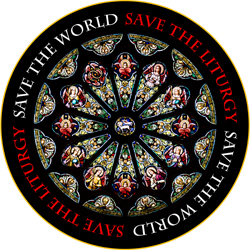From an address by His Eminence in St. Louis last year.
http://zenit.org/article-21477?l=english
Gregorian Chant
"Liturgical action is given a more noble form when sacred rites are solemnized in song" (SC, n. 113). There is an ancient saying: bis orat qui bene cantat, that is, "the person who sings well prays twice". This is so because the intensity that prayer acquires from being sung, increases its ardour and multiplies its efficacy (cf. Paul VI: Address to Italian Schola Cantorum, 25 September 1977, in Notitiae 136, November 1977, p. 475).
Good music helps to promote prayer, to raise the minds of people to God and to give people a taste of the goodness of God.
In the Latin Rite what has come to be known as the Gregorian Chant has been traditional. A distinctive liturgical chant existed indeed in Rome before St Gregory the Great (+604). But it was this great Pontiff who gave it the greatest prominence.
After St Gregory this tradition of chant continued to develop and be enriched until the upheavals that brought an end to the Middle Ages. The monasteries, especially those of the Benedictine Order, have done much to preserve this heritage.
Gregorian Chant is marked by a moving meditative cadence. It touches the depths of the soul. It shows joy, sorrow, repentance, petition, hope, praise or thanksgiving, as the particular feast, part of the Mass or other prayer may indicate. It makes the Psalms come alive.
It has a universal appeal which makes it suitable for all cultures and peoples. It is appreciated in Rome, Solesmes, Lagos, Toronto and Caracas. Cathedrals, monasteries, seminaries, sanctuaries, pilgrimage centres and traditional parishes resound with it.
St Pope Pius X extolled the Gregorian Chant in 1904 (cf. Tra le Sollecitudini, n. 3). The Second Vatican Council praised it in 1963: "The Church acknowledges Gregorian Chant as proper to the Roman liturgy: therefore, other things being equal, it should be given pride of place in liturgical services" (SC, n. 116).
The Servant of God, Pope John Paul II, repeated this praise in 2003 (cf. Chirograph for the Centenary of Tra Le Sollecitudini, nn. 4-7; in Congregation for Divine Worship and the Discipline of the Sacraments: Spiritus et Sponsa, 2003, p. 130).
Pope Benedict XVI encouraged the International Association of Pueri Cantores when they met in Rome at the end of 2005. They give a privileged place to the Gregorian Chant.
In Rome and throughout the world the Church is blessed with many fine choirs, both professional and amateur, that render the chant beautifully, and communicate their enthusiasm for it.
It is not true that the lay faithful do not want to sing the Gregorian Chant.
What they are asking for are priests and monks and nuns who will share this treasure with them.
The CDs produced by the Benedictine monks of Silos, their motherhouse at Solesmes, and numerous other communities sell among young people.
Monasteries are visited by people who want to sing Lauds and especially Vespers.
In an ordination ceremony of 11 priests which I celebrated in Nigeria last July, about 150 priests sang the First Eucharistic Prayer in Latin. It was beautiful.
The people, although no Latin scholars, loved it. It should be just normal that parish churches where there are four or five Masses on Sunday should have one of these Masses sung in Latin.
Subscribe to:
Post Comments (Atom)




No comments:
Post a Comment